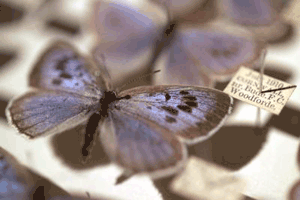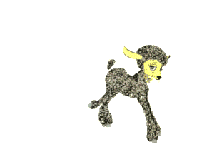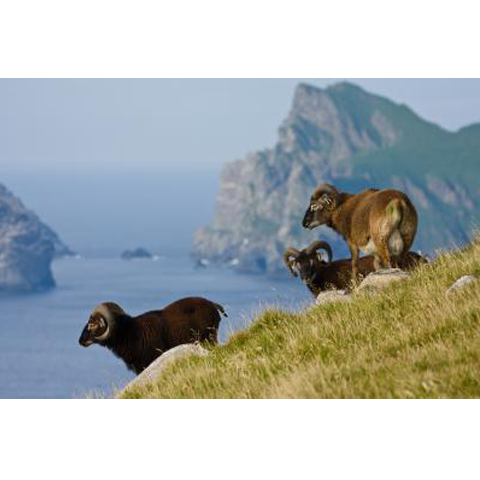Science news in brief
5-July-2009

The week in Real Science
The research below, chosen from hundreds of recently published papers, ranges from sheep to the giant moa, from moonshine to even cooler lighting. Take a look:
2 July 2009 Climate change and shrinking sheep
Changing winter conditions are shrinking Scotland's Soay sheep, despite the benefits of having a large body, researchers report.
2 July 2009 Scientists 'rebuild' giant moa using ancient DNA
Scientists have carried out the first DNA-based reconstruction of the giant extinct moa bird, using prehistoric feathers recovered from caves and rock shelters in New Zealand.
2 July 2009 New focus on the moon

The Lunar Reconnaissance Orbiter Camera has taken its first images of the Moon, kicking off the year-long mapping mission of Earth's nearest neighbor. The imaging system is under the watchful eyes of Arizona State University professor Mark Robison, the principal investigator.
2 July 2009 Plant clock can improve climate-change models
The ability of plants to tell the time enables them to survive, grow and reproduce. In a study published in the latest issue of Ecology Letters, an international team has studied this circadian clock and found an ecological implication: It can make climate change models more accurate.
2 July 2009 A question of height

Intelligent countryside management could improve the survival chances of animals and plants threatened by climate change. Creating small, heat-shielded habitats and better links between habitats would counter a moderate temperature rise, and give threatened species more time to adapt ir migrate to cooler regions.
2 July 2009 Lighting revolution forecast
New developments in a substance that emits brilliant light could lead to a revolution in lighting for home and office in five years, says materials scientist Colin Humphreys of Cambridge University. Gallium nitride is already used for camera flashes, bicycle lights, mobile phones and interior lighting for buses, trains and planes. Making it possible to use it for home and office lighting could reduce electricity consumption for lighting of a developed country by 75%, delivering major cuts in carbon dioxide emissions.
Education resources, classroom activities, cool stuff
Climate change
Let there be light
Editing gifs
Transcript of 5 July 2009 podcast
Shrinking sheep
Hello again and welcome to the Real Science review of the week.
Sometimes the science news stories that appear over a few days are unconnected to each other. More often they come in clusters. See how long it takes you to work out what the common theme is in these stories this week:
We've got the incredible shrinking sheep, how plants wake up an hour before sunrise, saving the Large Blue butterfly and lighting that suits your mood.
Let's take a quick look at some of these. Feel free to shout "Gotcha" or "Bingo" as soon as the connection clicks with you.
Over the top
Incidentally a weakness of science news by press release is that so many of them talk about breakthroughs, major advances and even revolutions. If these happened as often as press officers say they do, we'd have solved all science by now.
The claims are even less believable when they're talking about research that hasn't happened yet. So anything that mentions "a major revolution in five years", as does this week's item on new lighting technology, has to be taken with a large pinch of salt.
Soft lights
So what's all this about gallium nitride? Here's what the lead researcher Colin Humphreys wrote in the review of the eventful story of Shuji Nakamura – who first developed bright blue, green and white GaN light emitting diodes – that we link to in the resources section:
"This revolutionary technology may eventually replace all the light bulbs and fluorescent tubes in the world, thus saving huge amounts of energy."
Lighting is one of the main causes of greenhouse-gas emissions, he goes on, causing 1900 million tonnes of carbon dioxide to be given off by power stations every year. "This is three times the total CO2 emissions from aircraft, and is comparable to the total amount of CO2 emitted by cars."
I don't know about you, but I didn't know that. All the advice is about flying less and cycling more – which isn't easy for people going from Glasgow to London for a ten o'clock meeting. Nobody told me there are easier ways to make a difference. Or if they did I wasn't listening.
So come on boys; let's solve the practical problems (take a look at the link to the press release to see what those are) and give us gallium nitride lighting just as fast as you can.
Early risers
So how can plants know that the sun's going to rise in an hour? It's not as if they've an alarm clock that tells them it's time to get their leaves in gear and start hustling, is it? Well yes in a way it is. It's called a circadian clock.
How do we know? Well mainly from Arabidopsis thaliana, the unassuming little weed that starred in last week's podcast. So what's a circadian clock? Well the word comes from two Latin words: circa meaning about and dies meaning day. So circadian is the scientific word for something that happens once a day.
And as far as plants are concerned the most important thing that happens once a day is that breakfast – and lunch and dinner – appears over the horizon. Now if this takes them by surprise every morning, it's like expecting factory workers to jump out of bed and start banging out the baked beans on the assembly line right away.
They can't do it. They need a shower, a shave and a shampoo. They need their morning coffee. They need to wander around scratching their bums until their brains get into gear.
And so does your tree in the forest and your grass on the lawn. But existing models of climate change don't take account of this worldwide waking up. They assume that photosynthesis switches on with the sun and continues steadily, other things being equal, as long as the sun is up.
But the circadian clocks mean that trees and plants are like factory workers that get going gradually. The climate models being used to figure out just how bad it's going to get don't take account of this. They should, say the researchers. It would make them more accurate
Discussion topics
Have a listen to John Brown on the connection between circadian clocks and alternative splicing, last week's topic. Take a look at the links. The video chat by Gavin Schmidt on the Edge website is particularly good, since he's one of the researchers doing cutting-edge climate modelling. A lot of his talk takes a fair bit of prior knowledge to grasp, but it's worth skimming over the transcript to see if there's anything that appeals.
One of the more easily understood parts, and very useful for class discussions of climate change, is the section that goes from "Freeman Dyson has made a critique of models." to "I didn't get that sense when Freeman Dyson was talking about climate change."
Another is the following section from "... special relativity, that kind of stuff." to "climate change is not that kind of science."
Time and thyme
Well we're running out of time as usual so I'll keep the comment on the last two items short and end by pointing you to some good resources for climate change in the classroom.
So we've got shrinking sheep, which you might have seen in the news, and the Large Blue butterfly, which died out in Britain in 1979, and was successfully reintroduced.five years later.
It's worth taking a look at the lifestyle of this attractive insect, with its reliance on one species of ant that likes the grass a certain length. It's a fascinating interplay of ants, grass, rabbits and wild thyme that students could study and retell. What are the wider lessons we can learn from the story of its reintroduction?
Then there's the shrinking Soay sheep that made the news this week. It's not easy to unravel the science from the news coverage which is to say the least not big on science. Have a listen for instance to the brief interview, featuring Marks and Spencer sweaters and Big Macs, on the Today programme. (Second link in the resources section.)
As always to get at the real science ask yourself what it is you don't understand. Something that strikes me right away is what looks like a contradiction between the story of the hobbits a few weeks ago and these sheep. Take a look at insular dwarfism, the fact that animals living on islands often get smaller, and see if you can find out if these researchers took that into account, as you'd expect them to.
Climate change resources
As you've no doubt realised by now the common theme in all these stories is climate change, which is hardly surprising as its effects are beginning to be felt all over the natural world.
There are a lot of classroom resources out there, and I'll point you to a couple. As usual Teachers' Domain is good, practical and varied. The Real Climate blog, written by climate scientists - including Gavin Schmidt, whose video interview with Edge we've already mentioned - is definitive for up-to-the-minute comment on climate change issues.
Technical and authoritative when necessary this blog also engages with non-specialists "to provide a quick response to developing stories and the context sometimes missing in mainstream commentary."
Their latest post is particularly relevant to Real Science: Most media items about science are related to new hot-off-the-press studies, they write. But this weight of coverage given to these state-of-the-art studies can give a misleading impression about the state of scientific knowledge. The more mature and solid a field, the less controversy there is and thus the fewer news stories.
"This means the public is told the least about the most solid aspects of science."
Finally take a look at the Find More section in Real Science, which searches a selected set of websites. The first hit on climate change is a winner right away with a host of good links to educational stuff, including the Climate Change Collection - "developed by a team of science teachers, climate scientists and learning experts who reviewed hundreds of resources for accuracy and effectiveness."
The collection includes background materials, web portals, classroom activities and reseach on misconceptions about weather and climate.
Right, that's all for this week from Real Science. We've gone way over time, so apologies for that.
Keep thinking.
And stay cool.
More help with words
absorbs, ultraviolet radiation, fossil fuels, greenhouse gas, arrogant, pretentious, industry, unifying


